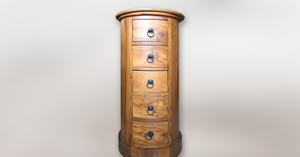How to choose the right wood for furniture: hardness, moisture content and thickness
Choosing the right wood is crucial to the quality and durability of furniture. The hardness of the wood directly affects its wear resistance , durability , and feel . Additionally, moisture content and wood thickness play an important role in determining furniture quality. In this article, we will explore the different wood species, commonly used European woods, and the impact of hardness, moisture content, and thickness on furniture selection.
1. Common wood species on the European furniture market
Different wood species are used in furniture making due to their properties and applications. Although softwoods are less hard, they are widely used due to their availability and ease of processing. Hardwoods such as teak and suar , on the other hand, are characterized by greater strength and durability and are preferred for high-quality furniture.
| Wood type | Janka hardness (lbf) | Main features |
|---|---|---|
| Jaw | 380 | Cheap, easy to process, but easily scratched |
| spruce | 510 | Lightweight and stable, often used in construction and musical instruments |
| cedar | 350 | Pest-resistant, aromatic, ideal for storage furniture |
| Ash | 1,320 | Shock-resistant, suitable for tool handles and floors |
| oak | 1,360 | Durable and moisture-resistant, often used for furniture |
| beech | 1,300 | Uniform grain, shock-resistant, widely used in furniture manufacturing |
| maple | 1,450 | High hardness, wear-resistant, suitable for musical instruments and floors |
| walnut | 1,010 | Dark grain, ideal for furniture |
| teak | 1,500 | Extremely weatherproof, corrosion-resistant, ideal for high-quality furniture |
| Suar/Acacia | 1,410 | Unique grain, high-quality, robust and durable, ideal for solid table tops |
2. Hardness: A decisive factor when choosing furniture wood
The hardness of the wood is an important factor when choosing furniture wood. Hardwoods such as teak and suar offer many advantages:
- Wear resistance: Hardwood lasts longer and is less susceptible to scratches and wear.
- Feel: The wood feels smoother and of higher quality.
- Durability: Hardwood is more stable and durable, which increases the lifespan of the furniture.
- Aesthetics: Dense wood fibers create a fine and even grain.
3. Moisture content: influence on the stability of the wood
The moisture content of the wood is another crucial factor for its stability. The ideal moisture content is between 8% and 12% , as wood remains stable within this range and does not crack or deform. Wood that is too dry or too moist is prone to cracking and deformation, which can compromise its quality.
4. Wood thickness and total area
The thickness and total surface area of the wood are also important factors that influence the value and quality of the furniture. The thicker the wood and the larger the surface area, the higher the value of the piece of furniture. Many furniture manufacturers use wood less than 5 cm thick and combine small pieces of wood into larger panels to save costs. However, this method can compromise the durability and stability of the furniture.
Some furniture pieces combine wood of different thicknesses and materials for the exterior and interior surfaces to reduce costs while improving the external appearance.
5. Teak and Suar: Application
Teak (teak wood)
- Hardness: 1,500 lbf
- Properties: Natural water resistance, resistant to pests and rot, rich in oils, extremely weather-resistant.
- Use: Ideal for outdoor furniture, decks and luxury indoor furniture.
Suar (suar wood)
- Hardness: 1,410 lbf
- Properties: Varied grain, robust and durable, with pronounced color contrast.
- Use: Ideal for dining tables, sculptures and decorative furniture.
6. Conclusion: Choose the right wood for high-quality furniture
Choosing the right wood determines the quality and durability of furniture. Hardwoods like teak and suar are characterized by their durability, beautiful grain, and high strength , making them ideal for high-end furniture. Softwoods like pine and spruce offer a more cost-effective option but are better suited for certain applications.
FAQ: Wood for furniture – frequently asked questions
1. Why is the hardness of wood so important for furniture?
Hardwoods like teak and suar are particularly durable, scratch-resistant, and retain their beautiful finish for many years. This makes them the first choice for quality furniture.
2. What moisture content is ideal for furniture wood?
A moisture content of 8–12% ensures that the wood remains stable and does not warp or crack. This is especially important for the Swiss climate.
3. How can you recognize high-quality solid wood?
Look for consistently thick, large wooden panels with no visible glue joints. High-quality furniture is usually made of woods like teak, suar, or oak and feels heavy and solid.
4. Which types of wood are particularly suitable for high-quality furniture?
Teak and suar score highly for their durability, beautiful grain, and unique feel. Teak is particularly popular for indoor and outdoor use.
5. Why is wood thickness so important in furniture?
Thick solid wood panels (5 cm and above) increase the stability and durability of the furniture. Thinner panels or glued wood composites often reduce quality.

